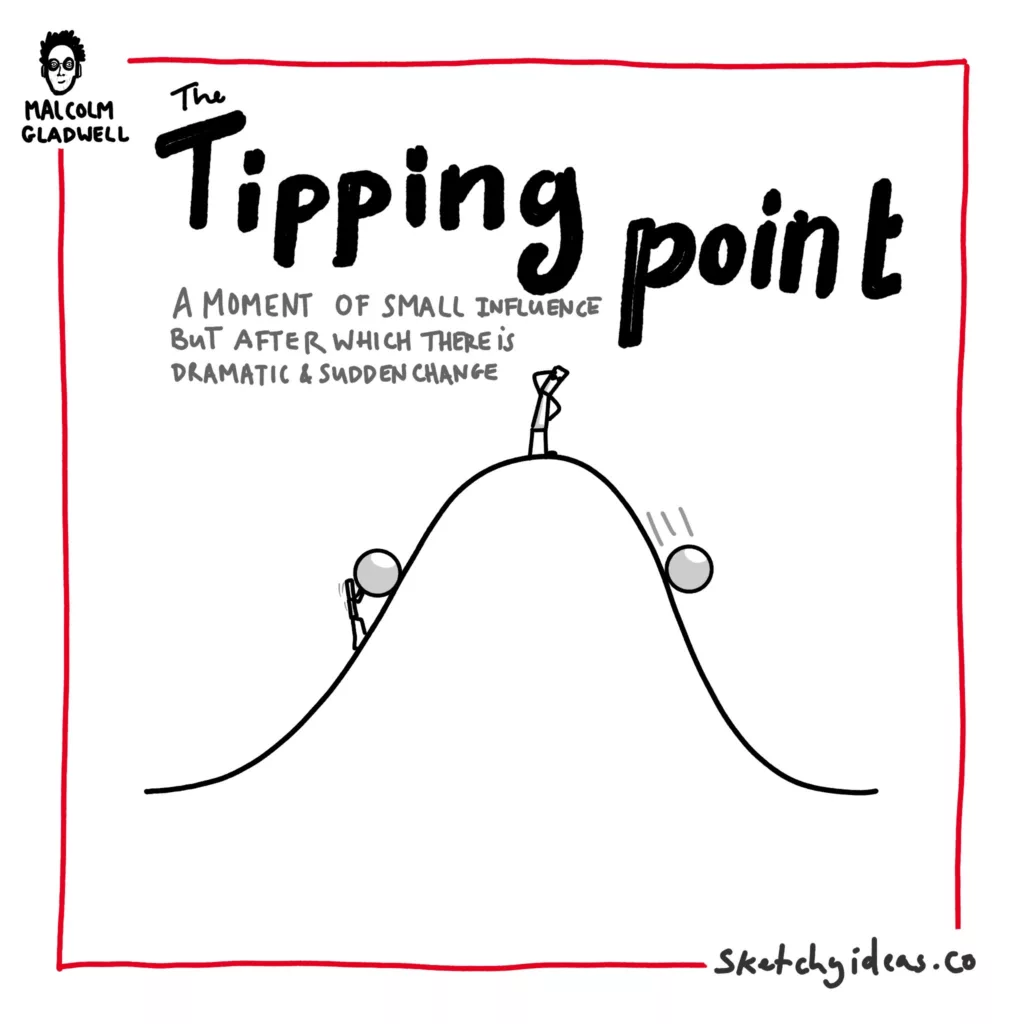Have you ever noticed that some trends seem to emerge out of nowhere but take the world by storm?
It can seem strange, especially when it’s a product that’s been around for a while. In fact, it’s more common that you might expect. And the reason why is today’s mental model.
It’s called The Tipping Point and it has a lot of implications.
What is the Tipping Point?

The tipping point is a mental model about change coined by Malcolm Gladwell in the book of the same name. It’s represented by a hill. Going up the hill (getting an idea going) is very difficult and hard work, but once you’re over the hill, it’s easy and required no work. The key insight is that the change from before and after is often tiny — a mere centimeter of our hill. But once we have crossed that point, everything changes.
Why the Tipping Point matters?
Understanding this mental model can have big implications for any project which you want to get off the ground.
Adjusting your expectations and setting good goals
Overnight success is a myth and the tipping point explains why.
While some artists and trends do go from nothing to the next big thing overnight, it comes after a lot of unseen hard work. If you are expecting to be a success straight after you start, you’re more likely to give up.
You need to put in the work till you reach your critical mass.
Exponential Growth:
But there is a positive side too.
Reaching a tipping point will lead to exponential growth. Although it requires a lot of work first, one small change or action can lead to rapid change as things finally take off.
Transformative Impact:
Tipping points can change societies.
These trends can be small, like the brand of trainers people wear, or larger, like the boycott and eventual abolition of the transatlantic slave trade. By reaching a tipping point, we can create an impact beyond what we can do alone.
How do you reach a Tipping Point?
Reaching a tipping point is a clear cut process, but there are some general rules which can help you make it more likely to achieve one.
Identify key influencers:
Some people and actions have more influence than others.
If you can identify who has more influencer or connections within a network, you can help you ideas spread faster. Don’t just look at the loudest voices, sometimes people have lots of significant connections even though they aren’t well known.
These influential individuals can accelerate reaching a tipping point.
Harness social proof:
Even the most contrarian individuals want to be part of a group.
Social proof shows that they are not alone. It includes testimonials, case studies, endorsements, basically anything which shows others like it. This is extremely important before you reach a tipping point; it shows the validation that comes naturally from reaching a tipping point.
Create contagious content:
Having a compelling idea isn’t enough.
If you want something to take off, you need to make it more sharable. This will help attract people to it, and encourage them to pass it on to. Content that evokes emotion, provides value, or sparks conversations has a higher chance of gaining traction and reaching a wider audience.
How could you package an idea so it’s more shareable?
Timing and Context:
Nothing else in the world…not all the armies…is so powerful as an idea whose time has come.
Victor Hugo, The Future of Man.
If you plant a seed in the wrong kind of soil, it won’t grown.
The same is true of ideas. If the environment isn’t right, you’re going to have greater resistance. If you can show how an idea applies to now, it’s more likely to be adopted.
Pay attention to cultural shifts, societal needs, and emerging trends to help get to a tipping point.
Are you heading for a tipping point?
Tipping points can have huge impacts on our lives from seemingly minor changes.
By applying this mental model and its implications, we can position and share our ideas, initiatives and products to help them gain as much influence as possible. And while it make still take time to reach a tipping point, there are shortcuts that can help us.
Just make sure you use this knowledge to create positive change.
Related ideas
- Network effects
- Critical mass
- Inertia

Leave a Reply